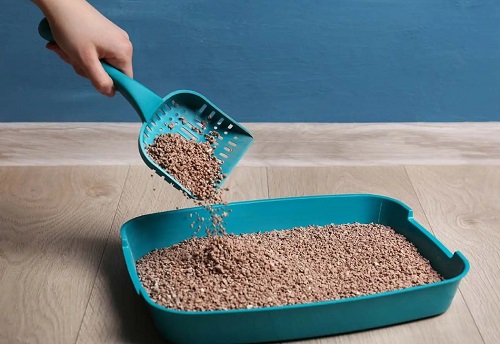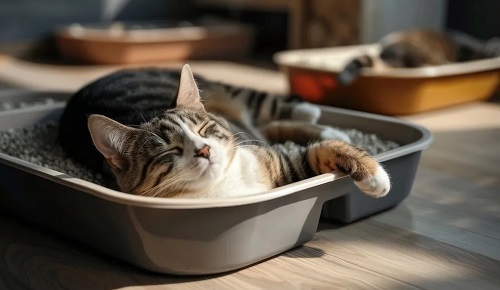Keeping your home fresh and odor-free with a cat requires more than just a pleasant-smelling litter box. The frequency with which you change your cat litter box plays a crucial role in maintaining a clean environment for both you and your pet. The question of how often to change cat litter box is not just about cleanliness; it’s about ensuring your cat’s comfort and health, as well as preserving the overall freshness of your home. In this guide, we’ll explore the best practices, factors, and signs that determine when it’s time to change the cat litter box. By understanding these key aspects, you’ll be well-equipped to keep your home smelling great while providing a clean space for your feline friend.

How Frequently Should You Change the Cat Litter Box?
Daily vs. Weekly Cleaning: What’s the Best Approach?
When it comes to changing the cat litter box, daily and weekly cleaning schedules both have their merits. Daily cleaning involves scooping out clumps and solid waste to maintain a cleaner environment, reducing odors and making the litter box more appealing to your cat. This approach is particularly effective in multi-cat households, where the litter box can become soiled quickly. On the other hand, a weekly cleaning schedule typically involves completely replacing the litter and thoroughly cleaning the litter box with soap and water. This method ensures that bacteria and odor-causing agents are eliminated, providing a fresh start for the week. The best approach often depends on your cat’s habits and your household’s specific needs. While daily scooping is essential for keeping odors at bay, a weekly deep clean is recommended to maintain overall hygiene.
Factors That Influence How Often to Change Cat Litter
Several factors can influence how often you should change the cat litter box. The number of cats you have is a significant factor; more cats typically mean more frequent changes. The type of litter you use also matters—clumping litter may require less frequent full changes compared to non-clumping varieties. Your cat’s health and behavior are other considerations; cats with certain health issues may need a cleaner litter box more often. Additionally, the size and ventilation of the room where the litter box is located can impact how quickly odors build up, influencing the frequency of changes. Understanding these factors will help you tailor the litter box maintenance schedule to your specific situation, ensuring both your cat’s comfort and the freshness of your home.

Signs That It’s Time to Change the Litter Box
Recognizing Odor as an Indicator
One of the most obvious signs that it’s time to change the cat litter box is the presence of a strong odor. If you start noticing an unpleasant smell, even after daily scooping, it’s a clear indicator that the litter needs to be replaced. Odors can develop quickly, especially in smaller spaces or in homes with multiple cats, so it’s essential to stay alert to any changes in the scent of the area around the litter box. Regularly changing the litter and cleaning the box will prevent the buildup of ammonia and other harmful compounds, keeping the air in your home fresh and clean.
Behavioral Signs Your Cat Needs a Clean Litter Box
Your cat’s behavior can also signal when it’s time to change the litter box. If your cat starts avoiding the litter box, or if they begin eliminating outside of it, this could be a sign that the box is too dirty for their liking. Cats are naturally clean animals, and they prefer a clean and fresh-smelling environment for doing their business. Other behavioral signs include excessive scratching around the litter box or spending less time in the area. Paying attention to these behaviors can help you recognize when it’s time to give the litter box a thorough cleaning.
How to Extend the Freshness of Your Cat’s Litter Box
Extending the freshness of your cat’s litter box involves a combination of regular maintenance and using the right products. Daily scooping is essential, but you can also add odor-control products like baking soda or specialized cat litter deodorizers to keep the litter box smelling fresh for longer. Additionally, using a high-quality, clumping cat litter can help trap odors more effectively, reducing the frequency of full litter changes. Another tip is to regularly clean the litter box itself with mild soap and water, and make sure it’s thoroughly dry before adding fresh litter. Keeping the litter box in a well-ventilated area can also help dissipate any lingering odors. By following these steps, you can maintain a clean and pleasant environment for both your cat and your home.
What Happens If You Don’t Change the Cat Litter Box Regularly?
Failing to change the cat litter box regularly can lead to several negative consequences. The most immediate issue is the buildup of strong, unpleasant odors that can permeate your home. Over time, this can make your living space less enjoyable for you and your guests. More importantly, an unclean litter box can affect your cat’s health. Ammonia from urine can accumulate, leading to respiratory problems or urinary tract infections in cats. Behavioral issues may also arise, as cats may refuse to use a dirty litter box, leading to accidents around your home. In extreme cases, this can cause long-term litter box aversion, making it difficult to retrain your cat to use the litter box. Regular maintenance is key to avoiding these problems and ensuring a healthy, happy environment for your cat.
Conclusion
In conclusion, knowing how often to change cat litter box is crucial for maintaining a fresh and odor-free home. By understanding the factors that influence litter box cleanliness and recognizing the signs that it’s time for a change, you can ensure that both your home and your cat remain happy and healthy. Regular maintenance, including daily scooping and weekly deep cleans, along with using the right products, can significantly extend the freshness of your cat’s litter box. Remember, a clean litter box not only benefits your cat but also contributes to a more pleasant living environment for everyone in your household.
FAQ
1.How often should you completely change the litter in a cat box?
It’s recommended to completely change the litter in a cat box at least once a week, depending on the type of litter and the number of cats in your home. Clumping litter may extend this period slightly.
2.Can you add new litter to old litter?
While you can add new litter to old litter to extend its use, it’s not a substitute for a complete change. Over time, even with scooping, the remaining litter can become saturated and start to smell, so regular full changes are essential.
3.What are the best cat litter options for odor control?
The best cat litter options for odor control typically include clumping litters with activated carbon or baking soda. These ingredients help trap and neutralize odors effectively, keeping the litter box fresh for longer periods.
